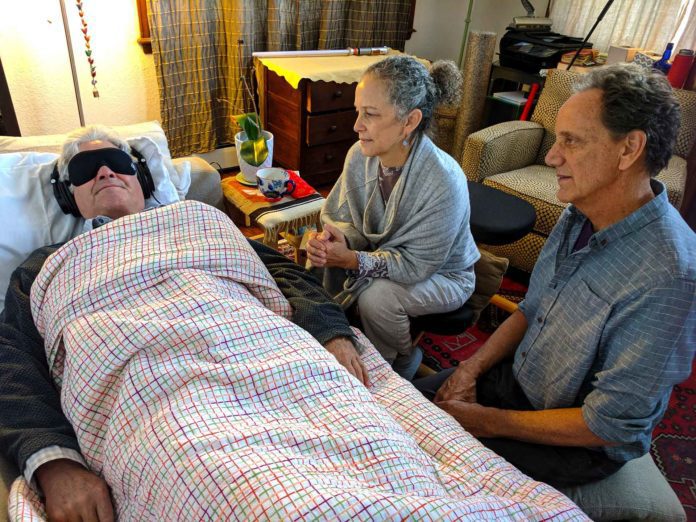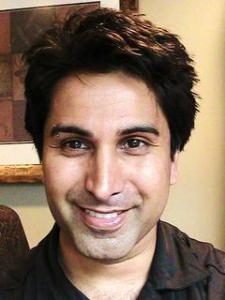This interview originally appeared in the MAPS Bulletin Winter 2014 Vol. 24, No. 3 – Annual Report. Featuring Annie Mithoefer, B.S.N., Shannon Clare Petitt, I.M.F., Saj Razvi, L.P.C., Ben Shechet, and Will Van Derveer, M.D, it sheds a great deal of light on MDMA-assisted therapy and the people behind MAPS.
Annie Mithoefer, B.S.N., is a co-investigator for MAPS’ study of MDMA-assisted psychotherapy for service-related PTSD in U.S. veterans, police officers, and firefighters in Charleston, SC. She is also a Registered Nurse, Grof-certified Holotropic Breathwork Practitioner and is trained in Hakomi Therapy and can be reached at [email protected].
Shannon Clare Petitt, I.M.F., is a co-therapist for MAPS’ study of MDMA-assisted psychotherapy for anxiety associated with a life-threatening illness. Her clinical work has been with individuals and groups, of all ages, experiencing trauma, addiction, depression, and dual-diagnosis. She can be reached at [email protected].
Saj Razvi, L.P.C., is a clinical researcher in MAPS’ study of MDMA-assisted psychotherapy for PTSD in Boulder, CO. He is Executive Director of the Trauma Recovery Institute in Denver, CO, and runs the trauma education program at the Univ. of Colorado Hospital’s CeDAR addiction treatment center. He can be reached at [email protected].
Ben Shechet is a Clinical Research Associate at MAPS. He received his BA in Psychology from Princeton University in 2009. Following his graduation, Ben spent a year as a Clinical Research Coordinator at a private clinical trials site, working primarily on studies investigating potential treatments for Alzheimer’s Disease. He can be reached at [email protected].
Will Van Derveer, M.D., is a clinical researcher in MAPS’ study of MDMA-assisted psychotherapy for PTSD in Boulder, CO. He is also part of the teaching faculty at the Love and Trauma Center. He is trained in EMDR, Somatic Experiencing and Containment and Resolution and is a long time meditator. He can be reached at[email protected].
MAPS: What excites you most about the field of MDMA-assisted psychotherapy research right now?
Annie: Michael [Mithoefer] and I have just returned from a very fulfilling training last month where we had the opportunity to share ideas and experiences with a wonderful group of other therapists working on MAPS studies. Learning from each other and supporting each other in this community of committed therapists and researchers is part of what excites me about this work. The other exciting and rewarding aspect is the privilege of getting to know the people who volunteer to participate in the studies, bringing so much willingness and courage to their healing journeys, and allowing us to play a part in supporting their healing process.
Shannon: So many conversations are taking place right now about new applications, designing new protocols, adding more measurements, and developing new study sites. While Phase 2 researchers are busy and full of enthusiasm with the current research, they and others can’t help but think about our expanse into Phase 3 in the coming years. What’s most exciting is that the possibility of MDMA-assisted psychotherapy as a treatment option is becoming a reality.
MAPS: Can you share any examples from current research that are teaching us something new about how people can recover from posttraumatic stress disorder (PTSD)?
Ben: One thing that I think is deserving of further study are a few patients in the currently ongoing PTSD studies who are displaying a markedly different pattern of symptom improvement. In a couple of cases, individuals with very severe PTSD are seeing only modest improvements in their symptoms during their participation in the study, and then at some point eight or nine months later, something “clicks” and their symptoms drop precipitously. I find this absolutely fascinating, because it seems to be pointing to the operation of some very deep healing processes that might not even be apparent or conscious for the patient. We talk a lot in theTreatment Manual about the subject’s “inner healing intelligence,” and this looks like a very profound example of this in action.
Saj: This is a fascinating point, Ben. I’ve seen that slower, more nuanced background process you describe. My sense here is that if a person develops deeper trust with their own experience and towards other people and the world in general, their filters or their defense mechanisms start allowing in more new and corrective experiences that were blocked previously. Developing this kind of trust in the live sessions is the gift that keeps on giving.
Shannon: Yes, this makes a lot of sense to me. During the MDMA psychotherapy session subjects often experience breakthroughs, profound realizations or new perspectives about their history or their behavior. The greatest part of healing is putting to action our breakthroughs. Subjects go home to familiar environments yet they are changed. It is a lot of work to adjust daily life to a new way, a lifestyle that supports being well.
MAPS: Why do you think some subjects experience improvements in their PTSD symptoms immediately after MDMA-assisted psychotherapy while for others it takes longer? What have you seen so far in the studies?
Will: We have certainly seen gradual and prolonged courses of recovery, which speaks to the need for long-term follow-up studies such as the one Michael and Annie published in 2013. Since our protocol is limited to three full-dose sessions, some people who have had several decades of PTSD symptoms have needed ongoing psychotherapy after the study. This raises an interesting question we have not yet addressed: for such people, would one or more additional sessions be useful? Some of our participants think so.
I also resonate with Saj’s point that after living with PTSD for many years, it can be a process to rekindle trust in one’s self and one’s own “inner healing intelligence,” a trust which is much easier to feel during the MDMA sessions. When one’s sense of self, the world, and one’s place in the world has mostly evolved through the lens of PTSD (as in the case of severe childhood trauma) it takes more effort to achieve a new way of seeing the self and the world. I have observed that each participant has a different course: Some are essentially “well” toward the end of the study, and others need more time to integrate the positive changes.
Annie: We have seen dramatic further improvements in the CAPS [Clinician-Administered PTSD Scale] over the one-year follow-up for at least three of our participants. Many others have reported ongoing improvements in other areas not captured by the CAPS; such as improved relationships, more trust in themselves, more creativity, and being more in the present moment. Some people have said the sessions changed their relationship to their emotions, so that even when painful emotions come up they are able to relate to them differently and move through them more easily. Each case is obviously very different, but I think there are a number of factors leading to continuing improvement. People have been able to reengage in activities they had stopped because of their PTSD symptoms, like going back to meaningful work, playing and writing music, singing, drawing, or painting again. These changes tend to build on each other and have a positive snowballing effect.
MAPS: Do you think that once MDMA-assisted psychotherapy is approved it has the potential to reach highly traumatized areas of the world that lack access to effective therapy? What do you hope to see develop in the future as far as reaching across cultural barriers to deliver more widespread and effective healing?
Saj: It is fair to say that recovering from trauma takes a lot of resources—including time, money, and energy on the client’s part and significant training and skill on the therapist’s part. Psychotherapy has been an elite privilege and has not been available to people in the most traumatized nations on the planet. MDMA profoundly decreases the level of resources needed by the client, and the amount of time needed from the therapist, to resolve even complex childhood PTSD.
Shannon: I really hope for MDMA-assisted psychotherapy to be available around the world. It is quite challenging to adapt psychotherapy to diverse cultures as the entire theoretical framework needs to be culturally attuned. Even translating our Treatment Manual into other languages has been difficult. We have been contacted by people around the world who want to research MDMA-assisted psychotherapy. One person emailed MAPS in the midst of war in his country and shared his anguish that many thousands of people were having traumatic experiences in front of his eyes, and yet the therapy he believed would be able to help them—MDMA-assisted psychotherapy—isn’t available.
Ben: It seems like at some level our whole culture is operating from a traumatized worldview. We have these fantastically technologically advanced systems, and more production capacity than we could ever possibly need, and yet there’s still this undertone of “What if I can’t secure enough resources to meet my needs?” and “I’ve got to get as much as I can for myself.” What often seems to happen with MDMA-assisted psychotherapy is that people who have faced really atrocious experiences, and have every reason to feel untrusting about life, suddenly get to tap into this experience of profound support, of profound holding, and in that space this willingness to trust again can emerge. When that happens, I think people can become much more willing to give of themselves and not hold on so tight. So I think MDMA-assisted psychotherapy has the potential for really wide-scale change, moving out of this mindset of struggling to stay alive, and more fully into the real dance of life.
MAPS: How do other treatment modalities complement MDMA-assisted psychotherapy in the treatment of PTSD? How do somatic therapies, bodywork, or other approaches inform the treatment process?
Saj: One of my big curiosities in the study is about the difference between cognitive/talk based therapies and somatic therapies, and whether there is a difference in results. The modality I teach and use as a therapist focuses on the autonomic nervous system to process both physical trauma and the more complex PTSD and transference that comes from repeated familial relational traumas. All mammals have pretty much the same ability to become stressed and traumatized that we do, since we all have the same basic mammalian autonomic nervous system setup. What that means is that stress and trauma are based in our more primitive biology rather than in the more recently evolved areas of cognition and consciousness.
The good news is that the mammalian nervous system has an inherent homeostatic mechanism that has developed over millions of years of evolution which is designed to regulate our responses to stress and trauma. Just as when we overheat our bodies sweat to cool us down, when we become stressed the body turns to its innate pathways to regulate and release traumatic charge. I see this mechanism at work in non-drug therapy sessions, and it becomes powerfully active during drug sessions. I think this self-regulating trauma mechanism is what we are referring to when we talk about the inner healing intelligence.
Participants who are able to process somatically can release a great deal of the traumatic charge through their bodies. After a car accident, we are shaky and panicked until our minds kick in and inhibit the response. I’ve seen this type of “fight-or-flight” response to a trauma get thoroughly processed during drug session when participants have the ability to trust and allow it to flow through their body. The session videos of people processing in their minds versus those processing in their bodies look very different.
Will: This is an interesting question. My orientation to the body’s essential role in PTSD recovery, from years of psychotherapy practice informed by Peter Levine’s Somatic Experiencing, certainly informs my work in the MDMA sessions. But there is another aspect that this question uncovers: With MDMA on board, the participants do not need to rely so much on the therapist to find the missing resources they need to face their traumatic memories and rewrite them. Because the inner healing intelligence is so present and so active in the participants, we don’t need to provide cues, suggestions, and structured therapeutic techniques which are so needed in ordinary therapy. Instead, the participant and the therapist both benefit from the massive resources provided by the MDMA, so that the splintered parts of the self can reintegrate.
Shannon: My orientation is from transpersonal psychology, though I am also a massage therapist and a dancer, and I very much believe in the body as a therapeutic tool, as the others have elaborated. A transpersonal approach acknowledges and works with a force within, between, and beyond the people in the room. People call this various names: the inner healer, the Spirit, angels, God, Love, life-force. It boils down to faith, which is a powerful healer. I’m not talking about religious faith, per say; I mean any kind of faith. Subjects entering our studies are incredibly faithful. Faith got them through their traumatic experience and it’s kept them alive. They are determined to heal and they hope there is a way to do so. The power of that belief alone is incredibly strong; the addition of MDMA in the therapy amplifies that power and helps it take root.
MAPS: Several of you are professional therapists in addition to being MDMA-assisted psychotherapy researchers. How does your work in the study inform your regular therapy practice, especially with regards to treating PTSD?
Shannon: The study sessions remind me to be creative with my clients. What sometimes happens in therapy is that it gets too comfortable: two people get into a rhythm and the process can stagnate. MDMA shakes loose routine and rigidity. It intensifies experiences, adds emphasis and humor, and brings up past events with new perspective. MDMA prompts both client and therapist to reevaluate the work, the story, their role, and ideas about what healing should look like. I enjoy finding new strategies to bring all of these elements into my regular therapy practice, without MDMA; it challenges me to bring my practice to a new level, to keep it alive.
Will: In my regular psychiatric practice, I continue to provide psychotherapy assisted by available medications and complementary treatments. My involvement in the study has changed my point of view on the available tools I have been using. Without MDMA, the patient and the therapist both have to work harder and longer to cure PTSD. This translates into more suffering, more cost, and more time disabled by symptoms. Many of our volunteers have tried most or all available treatments without relief. It is possible that our technique may change the practice of psychotherapy, on a scale akin to what has followed in medicine after the discovery of antibiotics. It is a profound privilege to bear witness to and learn from our participants’ healing journeys, each one of which is a lesson in human resilience and strength.
Saj: I am struck by how powerful corrective experiences can be in the processing of trauma. If you consider that trauma, especially during childhood, disrupts the attachment relationship we have to ourselves, to each other, and to the world, MDMA may work so well because it encourages nearly instant re-attachment at these levels. Once people have this corrective experience, they seem to have a natural impulse to engage and release traumatic charge. The study has fundamentally changed where I operate from as a therapist. I used to focus on being highly precise and technical with my interventions, now I operate from a much deeper experience of trust. It is not just me that holds the client; I’ve discovered an ocean that we all swim in that is profoundly supportive and loving.
MAPS: How would you describe this “inner healing intelligence” that seems to play such a powerful role in the process of PTSD recovery in MDMA-assisted psychotherapy?
Ben: It’s beyond me to get at the essence of it, but it’s in a sense a very precise, intuitive understanding of suffering. If I pick up a hot pan from the stove, I don’t engage in a cognitive process of “This pan is hot and it’s hurting me so therefore I’d better put it down.” The pan just gets dropped! In the same way, this intelligence seems to really clearly see what’s causing suffering, and in seeing it clearly, the attachment to it drops. I think it corresponds pretty closely to the phenomenon of “discriminating wisdom” described in Buddhism.
Will: The inner healing intelligence is the main character in the cast of inner parts in the unfolding of a session. I think the MDMA helps people unlock access to the inner healing intelligence. It is a “knowing beyond any doubt” as described by one participant. Because this knowing feels so trustworthy to the participant, there is no more questioning. It’s a presence akin to an inner divinity or soul, and it is recognized as self rather without question. Christians might call this “Christ consciousness,” and Buddhists might call it “Buddha nature.” The fragmented parts of the person are brought together by this presence. People take varying degrees of time and effort to trust this inner healer.
Annie: The Inner Healer has been described in many ways. I like the way Tav Sparks describes it in The Wide Open Door. He writes: “In some schools, it is called the Higher Self or the soul. In others, it is simply referred to as a healing mechanism. No matter what it is called, all systems are referring to that mysterious, and ultimately nameless, force within us that is in charge of our transformation.”
In our preparatory sessions we often use the analogy of a person with a wound. The doctor or nurse can help by removing obstacles, such as gravel and debris, and can create favorable conditions but it is always the person’s own healing intelligence that does the healing. In Body-Centered Psychotherapy, Ron Kurtz says that “psychotherapy is healing and healing only happens to living organisms…They don’t get fixed or repaired or anything like that. An M.D. can set a fracture, but he cannot heal it. He can help, but he cannot heal it.” Our trust in each participant’s inner healer allows us to be present as the healing process unfolds. Each session is different just as each moment is different, and if we are flexible and curious it creates a setting in which the inner healing intelligence will provide what is needed for healing. For instance, some people go directly to revisiting the trauma after the MDMA takes effect. Others may have a very affirming, even blissful, experience first, and report that’s what gave them the ability to process the trauma more effectively later on.
Saj: This is a great question. I appreciate what everyone has said about the inner healer because we seem to be naming different aspects of it. My sense is that the inner healer emanates from some aspect of our nature that exists underneath the trauma. It seems like most participants can touch a sense of themselves that feels unconditioned by their individual histories and trauma (it’s both egoic and transegoic at the same time), as well as tender, empathic, and yet very resilient. If feels both utterly familiar and yet forgotten. It is remarkable when people who don’t have any conscious experience of themselves as good see this quality emerge in their sessions as something they can touch in a deeply visceral way.
One quality of the inner healer that we’ve not talked about is its shadow side. It seems to me that inner healer shows up not just as the supportive element within the client’s experience, but also as the re-creator of the remembered trauma. Here’s what I mean: To process trauma, I think we need the traumatic foe or perpetrator to which we are responding to make an appearance. Even though we may find it vile and want nothing to do with that person, we internalize the entire scene of the crime (especially if it was within a family system), both the good and the bad. Although it is frightening for many of us as helpers to witness, allowing the inner healer to resurrect the trauma and allow it to express itself and ultimately be integrated is just another part of trusting the process.
Shannon: Yes, the Inner Healing Intelligence can be called many things: intuition, trust in self, deep knowing. We all dissociate at times, especially if there is a trauma response. The Inner Healing Intelligence is something that guides us even when we are disconnected. It’s like the body automatically breathing while you sleep. It is intrinsic to all people and operates with a level of wisdom often beyond our conscious thinking. Trusting the inner healer to do its job and guide us on the path of healing and growth can be frightening and can be comforting. The concept of the Inner Healing Intelligence respects that you are the only master of your world. The therapists and the MDMA are supporting characters and their role is to encourage the Inner Healing Intelligence to speak up!






